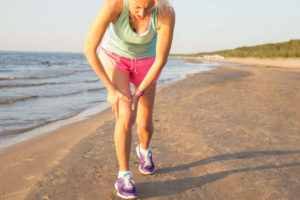Preventing ACL Injuries in Female Athletes
 With more young women participating in sports, incidence of injury is also climbing. The anterior cruciate ligament, or ACL, is one of the main ligaments of the knee that helps provide stability. In addition, the ligament is commonly injured. Female athletes have a 4 to 6 times higher incidence of ACL injury than do male athletes participating in the same landing and pivoting sports.1 A number of factors attribute to this. For example, anatomical differences between men and women, hormones, slower reaction time, and muscle imbalances. Sports that require more cutting and pivoting movements place more stress on the ACL. These sports included, soccer, volleyball, and basketball. The stressed placed on the ACL in sports such as running or biking is less. Read on to learn more about preventing ACL injuries in women.
With more young women participating in sports, incidence of injury is also climbing. The anterior cruciate ligament, or ACL, is one of the main ligaments of the knee that helps provide stability. In addition, the ligament is commonly injured. Female athletes have a 4 to 6 times higher incidence of ACL injury than do male athletes participating in the same landing and pivoting sports.1 A number of factors attribute to this. For example, anatomical differences between men and women, hormones, slower reaction time, and muscle imbalances. Sports that require more cutting and pivoting movements place more stress on the ACL. These sports included, soccer, volleyball, and basketball. The stressed placed on the ACL in sports such as running or biking is less. Read on to learn more about preventing ACL injuries in women.
Why Do Injuries Occur?
Females typically have wider hips than males. This creates a larger angle (or Q angle) between the upper and lower leg where they meet at the knee. This larger angle combined with hip weakness can be a recipe for disaster. Ideally, when an individual runs or jumps, their knee should track in line with the hip and foot. However, weakness of the hips, particularly the glutes, may lead to a collapse of the knees inward when running or jumping. This position of the knee is associated with higher rates of ACL injury. Depending on the injury and the individual, ACL injuries can be treated conservatively or may require surgery. After an ACL reconstruction surgery, a person can expect to have 6-8 months of rehab before returning to sport.
Who Can Help?
A Physical Therapist can complete an assessment and determine a person’s individual risk of injury. In addition, they can provide exercises and stretches to minimize that risk. Sport specific training and movement retraining are great options for sport performance and injury prevention. This helps not only strengthen muscles, but teaches the body how to move in real life situations, such as sports.
Helpful Exercises to Help Prevent ACL Injuries
What are some exercises I can do to prevent an ACL injury?
Specific exercise programs to fit each individual athlete’s strengths and weaknesses should be developed. However, there are several common exercises that could help decrease risk of ACL injury. Examples are as follows. A clamshell is a hip strengthening exercise where a person is lying on their side, knees and hips bent slightly, and the top knee moves towards the ceiling while the feet stay together (thus opening like a clam.) Side stepping with an exercise band around the ankles is another great exercise to help strengthen the hips. Side planks and squats are also excellent options. As with any exercise, the key is to focus on proper form and to work those muscles “to fatigue” meaning until the muscle is tired. In addition, exercises to strengthen the hamstrings can help decrease ACL injury risk as females tend to have weaker hamstrings compared to the quadriceps.
If you are concerned about preventing ACL injuries in a teenage athlete or yourself, feel free to call MOSAIC Rehabilitation and schedule an appointment today. You can also check out our blog on Minimizing Your Child’s Risk for Sports Related Injuries.
